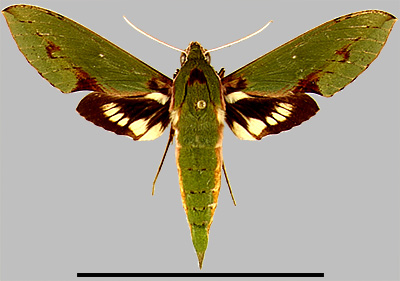Xylophanes chiron lucianus
Xylophanes chiron lucianus
zail-AH-fan-eesmm
KYE-ronmm
loo-see-AHN-uhs
Rothschild & Jordan, 1906

This site has been created by
Bill Oehlke at oehlkew@islandtelecom.com
Comments, suggestions and/or additional information are welcomed by Bill.
TAXONOMY:
Family: Sphingidae, Latreille, 1802
Subfamily: Macroglossinae, Harris, 1839
Tribe: Macroglossini, Harris, 1839
Genus: Xylophanes Hubner [1819] ...........
Species: chiron lucianus (Rothschild & Jordan 1906)
|
MIDI MUSIC
.....It's a Wonderful World.....
copyright C. Odenkirk
ON.OFF
<bgsound src="world.mid" LOOP=FOREVER>
|
DISTRIBUTION:
Xylophanes chiron lucianus is very common in Guadeloupe and
Martinique, in hygrophilic and mesophilic zones and is probably the
most abundant hawk-moth in Guadeloupe. This subspecies also flies in
St-Kitts and throughout the Lesser Antilles (not in dry islands). It
is also recorded from Martinique, La Trinité, Presqu'île de la
Caravelle.
St. Lucia is the specimen type locality.
The pronunciation of scientific names is
troublesome for many. The "suggestion" at the top of the page is
merely a suggestion. It is based on commonly
accepted English pronunciation of Greek names and/or some
fairly well accepted "rules" for latinized scientific names.
The suggested pronunciations, on this page and on other pages,
are primarily put forward to assist those who hear with internal
ears as they read.
There are many collectors from different countries whose
intonations and accents would be different.
Jean Marie Cadiou writes, "When I say "Xylophanes" in English I
pronounce it something like "Zailophanees", with the emphasis on the
"o". The French pronounce it differently, something like
"Kzeelophaness" with no emphasis, and the Germans yet in a
different way..."
In Greek myth, Phanes is the golden winged Primordial Being who
was hatched from the shining Cosmic Egg that was the source of the
universe. He personifies light emerging from chaos.
"Xylo" is the Greek word for wood.
The specimen type for the genus
Xylophanes is Xylophanes anubus. Perhaps ? when Hubner
examined this species, the yellow-orange and brown tones of the
forewings suggested wings of wood.
The species name "chiron" comes
from Greek mythology where Chiron is the wise centaur who
tutors Achilles, Hercules and Asclepius. The subspecies name is for
the specimen type locality, St. Lucia.
FLIGHT TIMES:
Xylophanes chiron lucianus probably broods continuously.
ECLOSION:
SCENTING AND MATING:Females call in the males with a pheromone released from a gland at the tip of
the abdomen. The females do come in to lights but not nearly as often as the males.
EGGS, LARVAE, PUPAE:
Larvae feed on Psychotria berteriana, Psychotria correae,
Psychotria microdon and Hamelia patens and Palicourea and Palicourea species
in the Rubiaceae family.
Use your browser "Back" button to return to the previous page.
Goto Main Sphingidae Index
Goto Macroglossini Tribe
Goto Central American Indices
Goto Carribean Islands
Goto South American Indices
Goto U.S.A. tables
